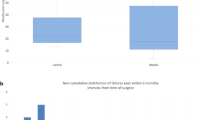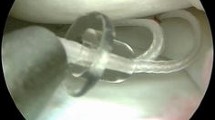Abstract
Purpose
Recently, it has been recognized that meniscocapsular (‘ramp’) lesions of the posterior one-third of the medial meniscus frequently occur during injuries causing ACL rupture, and that these lesions are easily missed at arthroscopy. Furthermore, it is clear that these lesions are biomechanically significant, adding to the deficits caused by ACL rupture, and that their repair can reverse this. The efficacy of an all inside repair technique has been questioned by some authors and by those who advocate a suture shuttle technique via an accessory posteromedial portal. The use of Ultra FastFix and FastFix 360 meniscal repair devices to repair posteromedial meniscocapsular separations was investigated in terms of safe deployment and the effectiveness.
Methods
Twenty cadaveric fresh frozen knees were used—ten in each of two groups. A ramp lesion was created using a Beaver knife. The lesion was then repaired with either 4 Ultra FastFix (Smith and Nephew) or 4 FastFix 360 (Smith and Nephew) meniscal repair devices. The knees were put through a standardized loading cycle consisting of 10 Lachman’s tests and ten maximum loading manual anterior drawer tests at 90° of flexion. Each knee was then flexed and extended fully ten times. The specimens were sectioned just proximal to the menisci and each suture anchor identified and its position recorded and photographed.
Results
In the Ultra FastFix group, a single anchor was found to be in an intra-articular position—a failure rate of 2.5%. In the FastFix 360 group, 5 anchors failed—a 12.5% failure rate. In all cases, the anchors were attached to their suture and so not truly loose within the joint.
Conclusions
This study confirms the safe and effective deployment of an all inside repair device for repair of medial meniscal ‘ramp’ lesions, and therefore its use is advocated in treating these difficult lesions. Ultra FastFix had the lower failure rate of 2.5%, which the authors believe is acceptable, and makes this device preferable to the FastFix360.






Similar content being viewed by others
References
Ahn JH, Wang JH, Yoo JC (2004) Arthroscopic all-inside suture repair of medial meniscus lesion in anterior cruciate ligament—deficient knees: results of second-look arthroscopies in 39 cases. Arthroscopy 20:936–945
Bollen S (2010) Posteromedial meniscocapsular injury associated with rupture of the anterior cruciate ligament. Bone Jt J 92:222–223
Choi N-H, Kim T-H, Victoroff BN (2009) Comparison of arthroscopic medial meniscal suture repair techniques: inside-out versus all-inside repair. Am J Sports Med 37:2144–2150
Ellermann A, Siebold R, Buelow J, Sobau C (2002) Clinical evaluation of meniscus repair with a bioabsorbable arrow: a 2-to 3-year follow-up study. Knee Surg Sports Traumatol Arthrosc 10:289–293
Grant JA, Wilde J, Miller BS, Bedi A (2012) Comparison of inside-out and all-inside techniques for the repair of isolated meniscal tears: a systematic review. Am J SportsMed 40:459–468
Hamberg P, Gillquist J, Lysholm J (1984) A comparison between arthroscopic meniscectomy and modified open meniscectomy. A prospective randomised study with emphasis on postoperative rehabilitation. Bone Jt J 66:189–192
Keyhani S, Ahn JH, Verdonk R, Soleymanha M, Abbasian M (2016) Arthroscopic all-inside ramp lesion repair using the posterolateral transseptal portal view. Knee Surg Sports Traumatol Arthros 24:1–5
Li W-P, Chen Z, Song B, Yang R, Tan W (2015) The FasT-Fix repair technique for ramp lesion of the medial meniscus. Knee Surg Relat Res 27:56
Liu X, Feng H, Zhang H, Hong L, Wang XS, Zhang J (2011) Arthroscopic prevalence of ramp lesion in 868 patients with anterior cruciate ligament injury. Am J Sports Med 39:832–837
Morgan CD (1991) The “all-inside” meniscus repair. Arthroscopy 7:120–125
Seil R, VanGiffen N, Pape D (2009) Thirty years of arthroscopic meniscal suture: what’s left to be done? Orthop Traumatol Surg Res 9:85–96
Smith JP, Barrett GR (2001) Medial and lateral meniscal tear patterns in anterior cruciate ligament-deficient knees a prospective analysis of 575 tears. Am J Sports Med 29:415–419
Sonnery-Cottet B, Conteduca J, Thaunat M, Gunepin FX, Seil R (2014) Hidden lesions of the posterior horn of the medial meniscus: a systematic arthroscopic exploration of the concealed portion of the knee. Am J Sports Med 42:921–926
Sonnery-Cottet B, Mortati R, Gadea F, Thaunat M, Moyere F, Chouteau J (2013) Osteolysis of the tibial plateau after meniscal repair with hybrid suture anchor. Knee Surg Sports Traumatol Arthrosc 21:2137–2140
Stephen JM, Halewood C, Kittl C, Bollen SR, Williams A, Amis AA (2016) Posteromedial meniscocapsular lesions increase tibiofemoral joint laxity with anterior cruciate ligament deficiency, and their repair reduces laxity. Am J Sports Med 44:400–408
Strobel M (1988) Menisci. Manual of arthroscopic surgery. Springer, New York, pp 171–178
Thaunat M, Fayard JM, Guimaraes TM, Jan N, Murphy CG, Sonnery-Cottet B (2016) Classification and surgical repair of ramp lesions of the medial meniscus. Arthrosc Tech 5:e871–e875
Vedi V, Spouse E, Williams A, Tennant S, Hunt D, Gedroyc W (1999) Meniscal movement. J Bone Jt Surg Br 81:37–41
Walgrave S, Claes S, Bellemans J (2013) High incidence of intraoperative anchorage failure in FasT-fix all inside meniscal suturing device. Acta Orthop Belg 79:689–693
Woods GW, Chapman DR (1984) Repairable posterior menisco-capsular disruption in anterior cruciate ligament injuries. Am J Sports Med 12:381–385
Funding
The authors would like to thank Smith and Nephew for providing meniscal repair devices and laboratory time.
Author information
Authors and Affiliations
Corresponding author
Ethics declarations
Conflict of interest
Smith and Nephew have provided financial support for research projects at Imperial College and some of the authors have received payment from Smith and Nephew for teaching.
Ethical approval
This project was approved by REC Wales approval 12/WA/0196, ICHTB HTA licence 12275, application number R14136-1A.
Informed consent
Consent was not required as this was a cadaveric study.
Electronic supplementary material
Below is the link to the electronic supplementary material.
Supplementary material 1 (MP4 1121 KB)
Rights and permissions
About this article
Cite this article
Heilpern, G., Stephen, J., Ball, S. et al. It is safe and effective to use all inside meniscal repair devices for posteromedial meniscal ‘ramp’ lesions. Knee Surg Sports Traumatol Arthrosc 26, 2310–2316 (2018). https://doi.org/10.1007/s00167-018-4976-5
Received:
Accepted:
Published:
Issue Date:
DOI: https://doi.org/10.1007/s00167-018-4976-5




